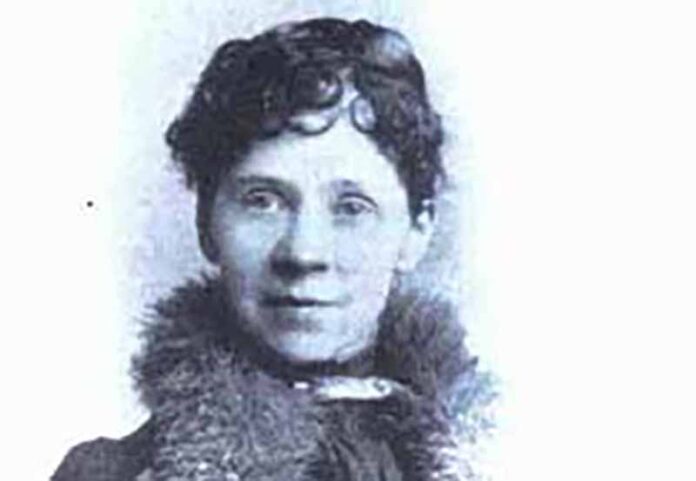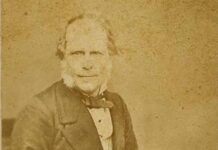A ground breaker in her time, Eliza Nicholson was the first woman publisher of a daily newspaper in the Deep South.
Eliza Nicholson was the first female publisher of a major American metropolitan daily newspaper. From 1876-96, Nicholson edited, owned, and published The Daily Picayune of New Orleans, Louisiana. The Picayune was heavily in debt when Nicholson began her tenure. She rescued the newspaper from bankruptcy by initiating daring innovations that improved its content and scope.
Pearl, a Poet, and the Picayune
Born Eliza Jane Poitevent on March 11, 1849, Pearlington, Mississippi, Eliza attended the Female Seminary of Amite, Louisiana, and graduated in 1867. She began her career as a poet and published her poems in a variety of periodicals under the pseudonym “Pearl Rivers.” Poitevent’s poetry appeared in The South, the Home Journal and Ledger, the New Orleans Times, and The Daily Picayune.
In 1873, “Rivers” published a collection of poems titled Lyrics by Pearl Rivers. It won critical praise from scholar Dr. W. H. Holcomb. In his review, he wrote: “The most striking characteristic of this poet is her subtle and ethereal personification of natural forms and forces, investing them with human thoughts and passions, thus spiritualizing, as it were, the whole world around us …. ‘Pearl Rivers’ has done well. She stands, by this volume, ahead of any other Southern poet, and no female writer in America … has evinced more poetic genius than shines throughout this little volume.”
In 1870, Poitevent was offered the position of literary editor at the Picayune. Her family objected to Eliza’s entering the workforce, yet despite their disapproval she accepted the position and moved to New Orleans. In her role as literary editor Poitevent was a novelty: she became the first Louisiana woman to earn a living by working for a newspaper.
Eliza married Alva M. Holbrook, editor and owner of The Daily Picayune, in May 1872. When Holbrook died in 1876, he left the paper to Eliza. The Picayune was $80,000 in debt, and Eliza was encouraged to liquidate. Instead, the twenty-seven-year-old widow assumed control of the paper as manager and editor, becoming the first woman publisher of a daily newspaper in the Deep South.
The Pioneer of Modern Newspaper Publishing
The Daily Picayune, established in 1837 and named after a Spanish coin, underwent significant changes during Eliza’s editorship. She boosted circulation by developing features that appealed to family interests with topics like medical advice, household hints, and fashion. She created the “Society Bee,” a society column that looked into the private lives of the New Orleans elite. Though the column was controversial and Eliza was accused of intruding into confidential matters, the “Society Bee” became one of the newspaper’s most popular and largest departments. She championed working women and temperance in the Picayune’s editorials. She advocated against cruelty to animals, writing columns against dog fighting and the whipping of horses and mules. She also created a comics section, a complaint department, and an advice column, which was written by Elizabeth Meriwether Gilmer under the penname of “Dorothy Dix” and titled “Sunday Salad.” “Sunday Salad” existed in syndication well into the 1940s.
In 1878, Eliza married George Nicholson, the Picayune’s business manager. Eliza relied heavily on her husband’s esteemed managerial skills to keep the paper going. Together, they cleared the paper’s debt. Thereafter, The Daily Picayune became a flourishing and influential business enterprise, and by the time of Eliza’s death in 1896, it had more than tripled its circulation.
Eliza was elected president of the Women’s National Press Association in 1884, and was designated president of the International Women’s Press Association in 1885. She returned to writing poetry and published “Hagar” (1893) and “Leah” (1894) in The Cosmopolitan. And in October 1890, Eliza was named the first honorary member of the New York Women’s Press Club. She was the only woman in her time honored with membership in The Associated Press.
Apart from Eliza’s vast and singular journalism achievements, editorials, and poetry, details of her life are scarce. However, as B. H. Gilley writes in A Woman for Women: Eliza Nicholson, Publisher of the “New Orleans Daily Picayune”:
“She was young and energetic; she was not a native of New Orleans, with access to loyalty based on family and cultural roots, but New Orleanians embraced her as one of their own. She was not a militant feminist who challenged men on their own ground; yet, any slight to women or to women’s abilities was addressed by the Picayune. Above all, Eliza Nicholson was not a figurehead. She achieved her reputation by bold and imaginative endeavor.
For a relatively short life of forty-seven years, in which she was … twice widowed, and reared two sons, Eliza Nicholson’s career accomplishments are remarkable.”
Eliza Nicholson died of influenza on February 15, 1896, ten days after the death of her husband, George.








